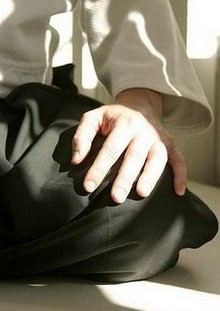Ki breathing is maximum inhalation and exhalation with the aim of improving normal breathing. Ki breathing consists of two basic elements: the diaphragmatic movement and the movement of the upper body. The diaphragmatic movement is the cornerstone of normal breathing, while the movement of the upper body, called chest breathing, should only come into play during exertion. To develop both well, there are a number of additional exercises that can be very helpful, especially for beginners.
The pure diaphragmatic movement can be practised very well while lying down. Place your hands on your lower abdomen and breathe in slowly through your nose towards your hands. You should feel the pressure of the inhalation all the way into the pelvic area. A good opportunity is to practise before falling asleep. You may even fall asleep while doing this. After you have practised lying down, you can try it sitting up and in any other position. The aim is to be able to direct the pressure of the inhalation into the lower abdomen at any time until this happens naturally with every breath. A certain amount of perseverance is important when practising, as physical changes always take some time.
A second, very important exercise is back breathing. This is best done while sitting, for example, by sitting on the floor with the knees drawn up. In this position, the back is rounded and the abdomen slightly compressed. Now inhale through the nose towards the back of the head so that the pressure of the diaphragmatic movement reaches the lower back to the right and left of the spine. You can control this movement with your hands, as with abdominal breathing. To do this, place your hands on your back and feel the movement that occurs during inhalation. The aim is to inflate the back so much that you can push another person’s hands away just by breathing in.
After these exercises, you should check in everyday life whether the movement of normal inhalation starts in the lower abdomen and also whether the back muscles move slightly with each inhalation. Good diaphragmatic breathing massages the muscles, but also the internal organs and also relieves the heart by pumping blood out of the abdomen.
For chest breathing, a flexible upper body is essential. For this, it is advisable to practise opening and closing the chest independently of breathing. The upper body is only secondary to breathing and must be able to move well independently of breathing. A simple way to make the upper body more flexible is to move the sternum up and down as much as possible, independent of breathing. To do this, take your fingers, press lightly on the centre of the ribcage and push the sternum up and down. The aim is to be able to move the chest up and down quickly while continuing to breathe normally. Of course, you can do the same movement without the help of your fingers, but for the beginning this can be helpful. This exercise not only improves the flexibility of the chest, which benefits Ki breathing, but is also important for many Aikido techniques.
Klaus Heß 07/2021 (translated with DeepL)
